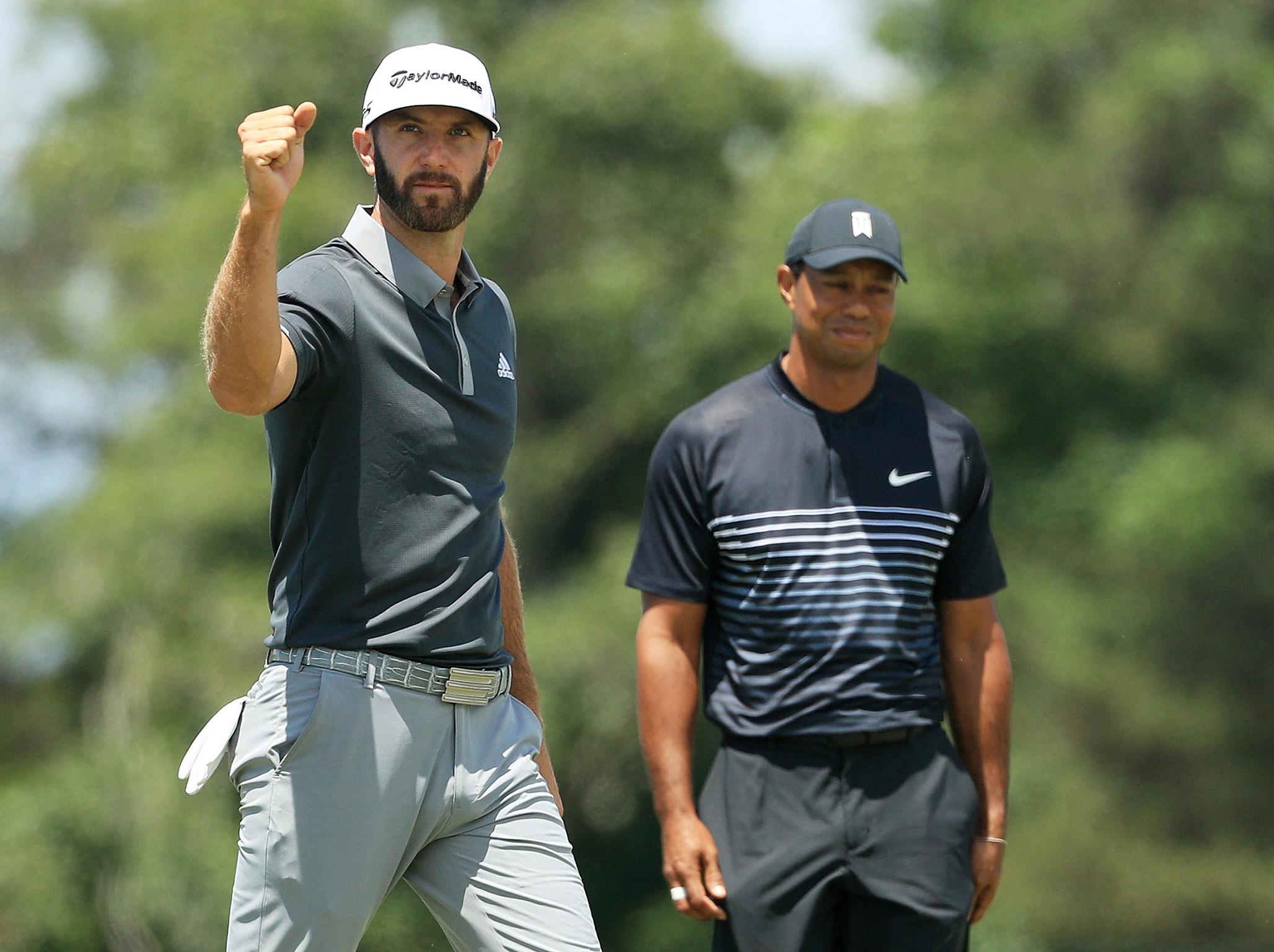US Open: Dustin Johnson drains long putt to pile pressure on late starters in second round
Johnson capped off another solid round in testing conditions at Shinnecock Hills with a 45-foot birdie putt on the par-3 seventh that dropped on its final turn

Your support helps us to tell the story
From reproductive rights to climate change to Big Tech, The Independent is on the ground when the story is developing. Whether it's investigating the financials of Elon Musk's pro-Trump PAC or producing our latest documentary, 'The A Word', which shines a light on the American women fighting for reproductive rights, we know how important it is to parse out the facts from the messaging.
At such a critical moment in US history, we need reporters on the ground. Your donation allows us to keep sending journalists to speak to both sides of the story.
The Independent is trusted by Americans across the entire political spectrum. And unlike many other quality news outlets, we choose not to lock Americans out of our reporting and analysis with paywalls. We believe quality journalism should be available to everyone, paid for by those who can afford it.
Your support makes all the difference.Dustin Johnson used the long ball to show how much was going his way in the US Open. Only it was the putter, not the driver.
Johnson capped off another solid round in testing conditions at Shinnecock Hills with a 45-foot birdie putt on the par-3 seventh that dropped on its final turn. He made only one bogey, was rarely out of position in the stiff breeze and light rain, and posted a 3-under 67 to set a daunting target for the late starters Friday.
“You’ve got to play really good golf if you want to shoot a good score, and I like where par is a good score on every hole, no matter what club you’ve got in your hand, what hole it is,” Johnson said.
Tiger Woods would have settled for par on the opening hole in either round. One day after he made triple bogey from the fairway on No 1, he again went from the fairway to deep grass right of the green, chipped it off the green on the other side and made double bogey. Woods rallied with two closing birdies to salvage a 72, and then had to wait to see if that would be enough to avoid missing the cut for the fifth time in his last eight majors.
“I’m not very happy the way I played and the way I putted,” Woods said. “I don’t know that you can be too happy and too excited about 10-over par.”
Johnson, who won the US Open at Oakmont two years ago, was at 4-under 136. He was the only player under par among those who played Friday morning in a strange mixture of weather that began with an overcast sky, gave way to two hours of light rain and then returned to mild sunshine.
Russell Henley was tied for the lead until he missed the third fairway and went into thick grass that change fortunes in a New York minute. He hit more grass than ball. He advanced his third shot into more rough. The grass wrapped around the hosel of the club and sent his fourth shot off to the right across the fairway to lighter rough.
He wound up with a triple bogey, shot 73 and was six shots behind.
Tommy Fleetwood of England made six birdies and shot a 66, the low score of the tournament, and was at 1-over 141. Henrik Stenson kept a clean card over his last 11 holes and made eagle on the par-5 16th for a 70. He joined Fleetwood at five shots behind.

Ian Poulter and Scott Piercy, who were tied with Johnson after the opening round, played in the afternoon. So did Phil Mickelson, Jordan Spieth, Rory McIlroy and Jason Day, all of whom were mostly concerned about first making the cut.
Johnson was concerned with staying out of trouble, and he has done that well on a punishing course. His best move of the week might have been on Thursday, when his ball finally was found in deep rough at No 6 and he considered going for the green, decided not to take on Shinnecock’s lone water hazard and eventually made bogey.
His only bogey on Friday, at the first hole, came from a conservative bunker shot to avoid rolling off the green.
“There were a couple times where I had a couple of bad iron shots, but every time I felt like I was able to save par, at least give myself a really good look at par,” he said. “My only bogey I made today, I still had a decent look at par.”
He picked up two of his birdies on the par 3s, an 8-iron to 8 feet on the scary 11th, and the long putt on No 7. Johnson hit 8-iron that went a little deep to the back of the green with a front pin, and all he cared about was the right speed.
“I’m trying to make it, but I was more focused on just making sure I had good speed,” Johnson said. “Hit a really nice putt, and it went right in there.”

Fleetwood was going the wrong direction Thursday afternoon, making a late birdie to salvage a 75. He hung around through the rain and then finished with three birdies over his last five holes.
“It can switch like that, and I think you just have to keep that in mind that you never know what’s going to happen, especially in a US Open,” Fleetwood said. “You don’t know what’s going to turn. You don’t know what the weather is going to do and how difficult it’s going to get. So as long as you keep going and hang in there, something might happen. Or it might not.”
That goes for Johnson, too. Stenson was asked if Johnson could be caught and said that the world’s No 1 player was “always catchable.” Stenson played with him in the final round at Shanghai last year when Johnson lost a six-shot lead in the final round.
AP
Join our commenting forum
Join thought-provoking conversations, follow other Independent readers and see their replies
Comments